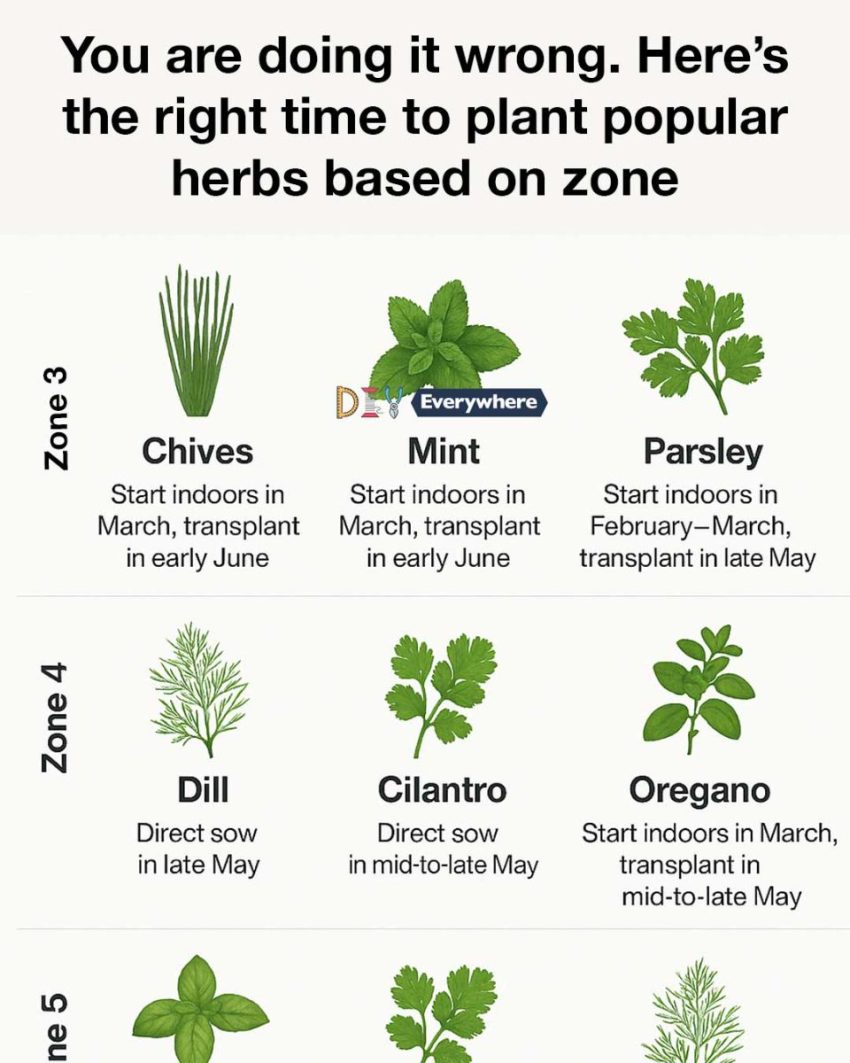Overview of USDA Plant Hardiness Zones
The USDA Plant Hardiness Zone Map is the standard by which gardeners and growers can determine which plants are most likely to thrive at a location. The map divides North America into 13 zones, each defined by a 10-degree Fahrenheit difference in the average annual minimum temperature. Zone 1 is the coldest, while Zone 13 is the warmest. This system helps gardeners understand the climatic conditions of their area and choose plants accordingly. Each zone is further divided into ‘a’ and ‘b’ subzones, offering even more precision for planting decisions.
Top 12 Popular Herbs and Their Ideal Planting Times
Some of the most popular herbs include basil, mint, rosemary, thyme, oregano, parsley, cilantro, chives, dill, sage, lavender, and tarragon. Each of these herbs has specific planting times based on the zone. For example, basil, which is sensitive to cold, should be planted after the last frost in zones 4-10. Rosemary, a more hardy herb, can be planted earlier in warmer zones. Understanding the ideal planting times for these herbs in your specific zone will help ensure a bountiful harvest.
Zone 3: Planting Guidelines for Cold Climates
Zone 3 is characterized by cold winters with minimum temperatures ranging from -40 to -30 degrees Fahrenheit. In this zone, the growing season is short, so it’s important to start herbs indoors or use cold frames to extend the season. Herbs like chives, mint, and parsley can be started indoors in late winter and transplanted outside after the last frost. Hardy herbs such as thyme and sage can also thrive in this zone if given a head start indoors.
Zone 4: Best Planting Practices for Cooler Regions
Zone 4 experiences minimum temperatures between -30 and -20 degrees Fahrenheit. The growing season is slightly longer than in Zone 3, but starting seeds indoors is still recommended. Herbs like dill, cilantro, and parsley can be sown directly into the ground after the last frost. Perennial herbs such as oregano and thyme can be planted early in the season to establish strong roots before the winter.
Zone 5: Optimal Planting Times for Transitional Climates
In Zone 5, with minimum temperatures ranging from -20 to -10 degrees Fahrenheit, the growing season is more forgiving. Most herbs can be planted directly outdoors after the last frost. Basil, cilantro, and dill thrive when planted in late spring, while perennial herbs like rosemary and lavender can be started indoors and transplanted outside once the soil warms.
Zone 6: Herb Planting Strategies for Mild Winters
Zone 6 offers a longer growing season with minimum temperatures between -10 and 0 degrees Fahrenheit. This allows for a wider range of planting options. Herbs like basil, parsley, and chives can be planted directly in the garden in mid-spring. Perennials such as rosemary and thyme can be planted in early spring to establish themselves before the heat of summer.
Zone 7: Planting Tips for Moderate Climates
Zone 7, with minimum temperatures from 0 to 10 degrees Fahrenheit, provides an excellent environment for most herbs. The growing season is long enough to accommodate multiple plantings. Basil, cilantro, and dill can be planted in early spring and again in late summer for a fall harvest. Perennials like lavender and sage thrive when planted in spring, allowing them to establish before winter.
Zone 8: Ideal Planting Periods for Warm Regions
Zone 8, where minimum temperatures range from 10 to 20 degrees Fahrenheit, offers a long growing season ideal for a wide variety of herbs. Most herbs can be planted in early spring, with a second planting in late summer for fall harvest. Basil, mint, and parsley do particularly well in this zone. Perennials like rosemary and thyme can be planted almost year-round, except during the hottest summer months.
Zone 9: Herb Planting Advice for Hotter Climates
In Zone 9, with minimum temperatures between 20 and 30 degrees Fahrenheit, the growing season is nearly year-round. Herbs can be planted in early spring or fall, avoiding the peak summer heat. Basil, cilantro, and dill can be planted in spring and again in fall. Perennials like rosemary and lavender thrive when planted in fall, allowing them to establish during the cooler months.
Zone 10: Best Practices for Tropical and Subtropical Areas
Zone 10, where minimum temperatures range from 30 to 40 degrees Fahrenheit, allows for year-round planting. However, it’s best to avoid planting during the hottest summer months. Herbs like basil, mint, and cilantro can be planted in fall and winter. Perennials such as rosemary and thyme can be planted in fall to take advantage of the cooler, wetter winter months for establishment.
Zone 11: Year-Round Planting Tips for Equatorial Regions
Zone 11, with minimum temperatures above 40 degrees Fahrenheit, offers a unique opportunity for year-round gardening. Herbs can be planted at any time, but it’s important to consider the rainy and dry seasons. Planting during the rainy season can reduce the need for irrigation. Basil, cilantro, and mint thrive in this zone, while perennials like rosemary and sage can be planted anytime, provided they receive adequate water.
Conclusion: Maximizing Herb Growth with Proper Timing
Understanding and utilizing planting zones is crucial for successful herb gardening. By aligning planting times with your specific zone, you can ensure that your herbs receive the right conditions for optimal growth. This not only enhances the health and yield of your plants but also reduces the risk of damage from frost or heat. With careful planning and timing, you can enjoy a bountiful herb garden that provides fresh flavors and aromas throughout the growing season.
